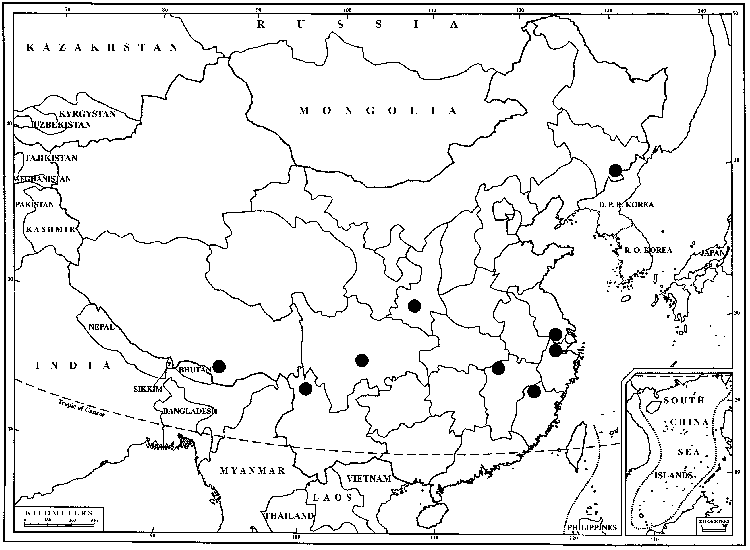Tuerckheimia svihlae
Bull. Buffalo Soc. Nat. Sci. 32: 94. 1993,.
Plants dull blue-green above, pale tan below, often pale yellow-green or in some environments all yellow, frequently finely white-powdered with calcareous deposit. Stems 0.5–1(–2) cm, irregularly branched, central strand weak; etomentose. Leaves linear-lanceolate, occasionally strap-shaped, 2–2.7(–4) mm; proximal region not differentiated or short-ovate, margins plane, entire, sinuate or shallowly sinuate-notched, apex long and narrowly acuminate, weakly channeled; costa short to long excurrent as a stout, sharp, conical mucro or subula, rarely subpercurrent; proximal laminal cells 12–17 µm wide, 2–3:1; distal laminal cells irregularly rounded-quadrate to angular-hexagonal, often horizontally elongate, (7–)10–12 µm wide, 1:1(–2), evenly thick-walled, superficial walls with thickenings forming high knobs or pads, marginal laminal cells not differentiated from medial cells or somewhat smaller, smooth or low-papillose, papillae when present massive, compounded of blunt lobes, centered over the cell, 1–2(–3) per lumen. Sporophytes not known from North America.
Habitat: Moist, calcareous rocks, dolomitic and limestone bluffs, limestone coves and sinks, caves, stream margins in hard and softwood forests
Elevation: low to moderate elevations (50-1000 m)
Distribution

Ark., Fla., Ky., N.C., Tenn., Mexico (Jalisco, Nuevo León, Tamaulipas), Asia (China, Japan, Korea).
Discussion
The leaf cells of Tuerckheimia svihlae having massive, centered, pillow-like papillae distinguish most specimens from similar taxa, which generally have lumens obscured by various densities of small, simple to 2-fid papillae. The frequently elongate, rounded fingerlike apical mucro on the leaf (up to and exceeding 26 µm in length) is distinctive. The specimen from Alaska cited by R. H. Zander (1978c) and mentioned later (Zander 1994f) was redetermined to be Didymodon vinealis (Zander, pers. comm.). Tuerckheimia svihlae is most often confused with Molendoa sendtneriana (Z. Iwatsuki and A. J. Sharp 1958; K. Saito 1972b), which has dense, small and simple papillae, a costa that is seldom excurrent, an apex that is generally flat and apiculate. The costa of Tuerckheimia svihlae is regularly excurrent into a stout, conic mucro and the apex is channeled by erect or upturned margins. The tufts of T. svihlae are yellower than the blue-green of the Molendoa species; those of T. svihlae are less coherent and often disintegrated, the stem leaves appearing flaccid and more chaotically twisted when dry. Specimens of Gymnostomum and Hymenostylium often have only subpercurrent to short-excurrent costae, as well as scattered simple to 2-fid papillae. Hymenostylium recurvirostrum is similar in the irregularly angular, pellucid laminal cells but is also distinguished by the absence of an adaxial costal epidermis, the absence of a stem central strand, and presence of red tomentum on the stem. Occasionally the papillae of Tuerckheimia svihlae are reduced to a smooth lens-shaped cap on the lumen surface. Another distinctive character is the leaf base commonly not distinguished in shape or areolation. When some differentiation is evident, it is in the basal 1/8–1/6 of the leaf, whereas in other species it extends much higher—to 1/4 the leaf length. Trichostomum tenuirostre, which may have similar long, ribbonlike leaves, has a distinctive Tortella-like leaf like leaf base of lax, hyaline cells usually extending somewhat up the margins and scattered small laminal papillae. Amphidium mougeotii and A. lapponicum are similar to Tuerckheimia svihlae in leaf length and shape. Amphidium mougeotii has papillae over the basal cells arranged in striations, while A. lapponicum has dense, small, sharp papillae over the laminal leaf surface and not concentrated over the cell lumen; the stems of both are red-tomentose, have relatively dark, clear green leaves, and the proximal cells of the leaves are more strongly differentiated from the medial distal cells.
Selected References
None.
